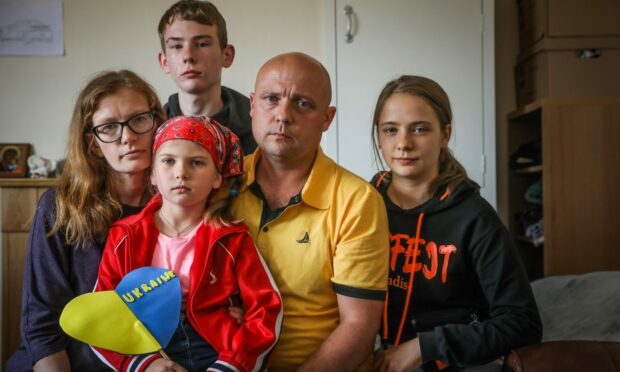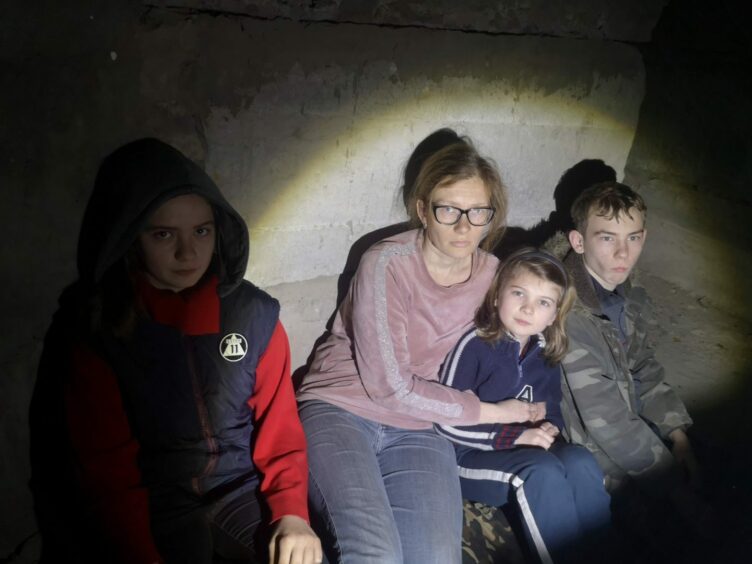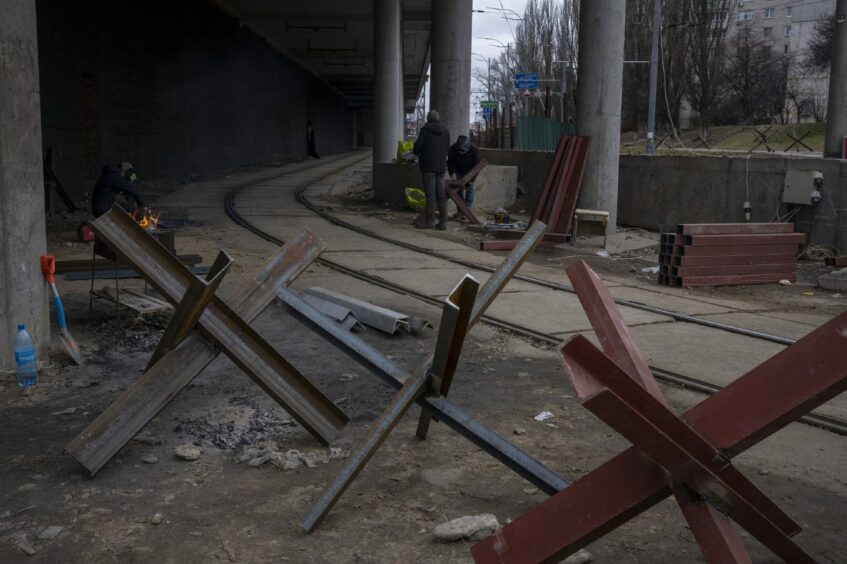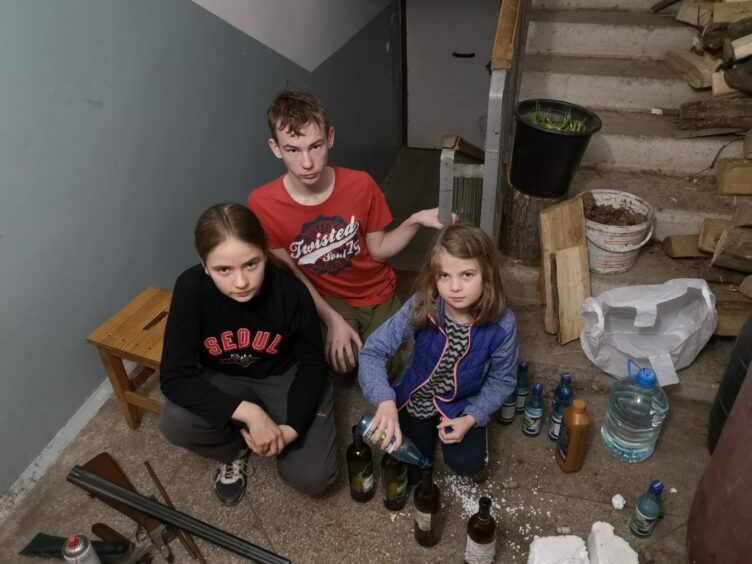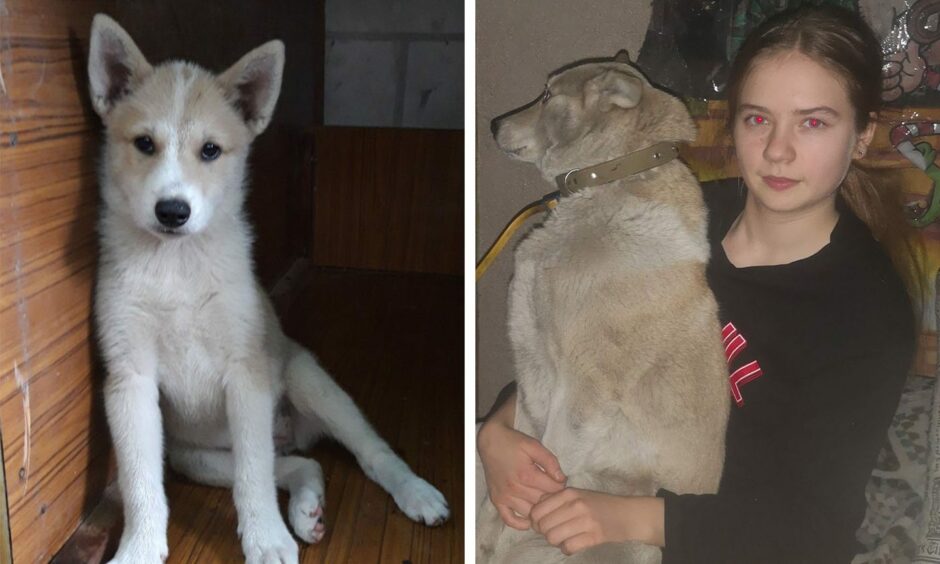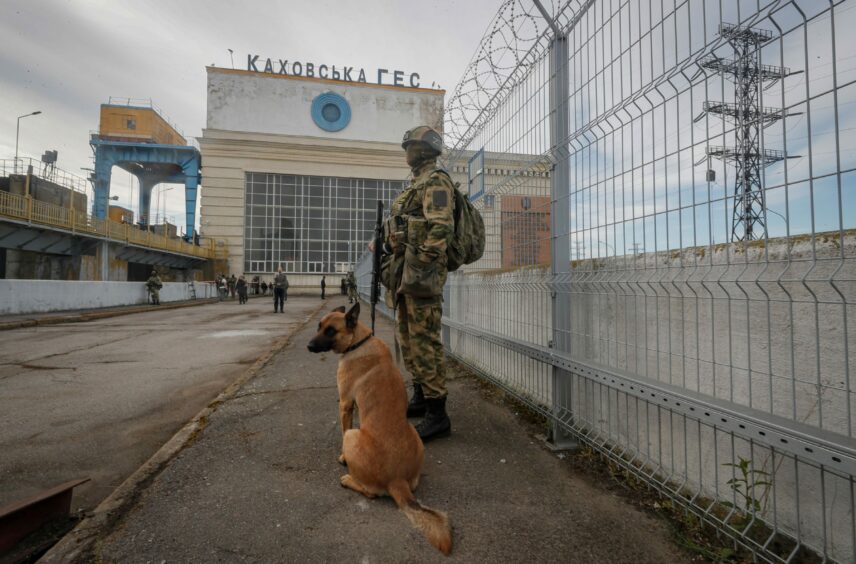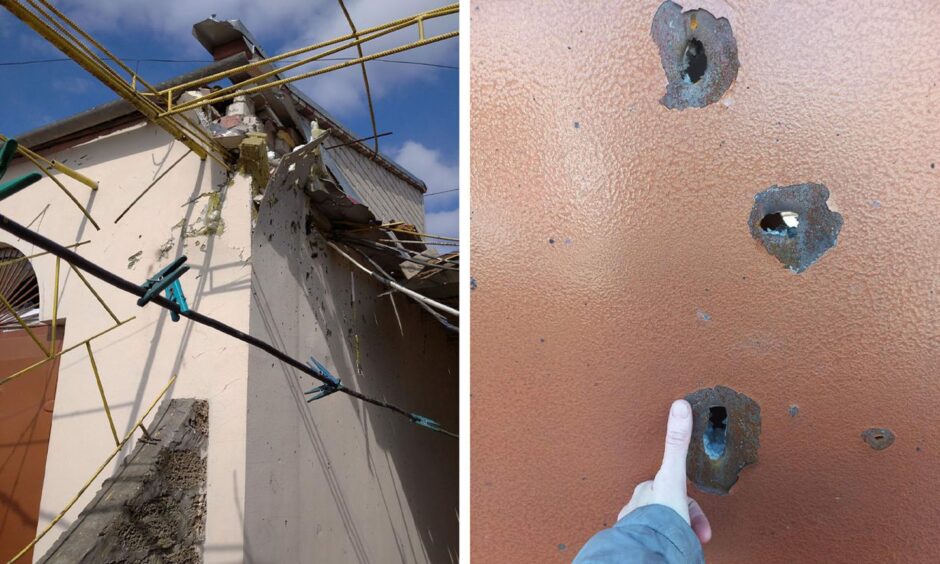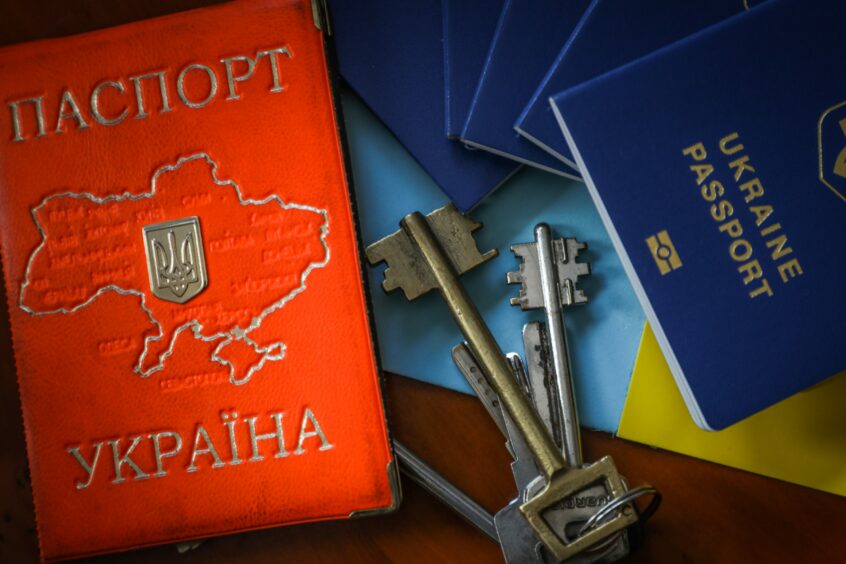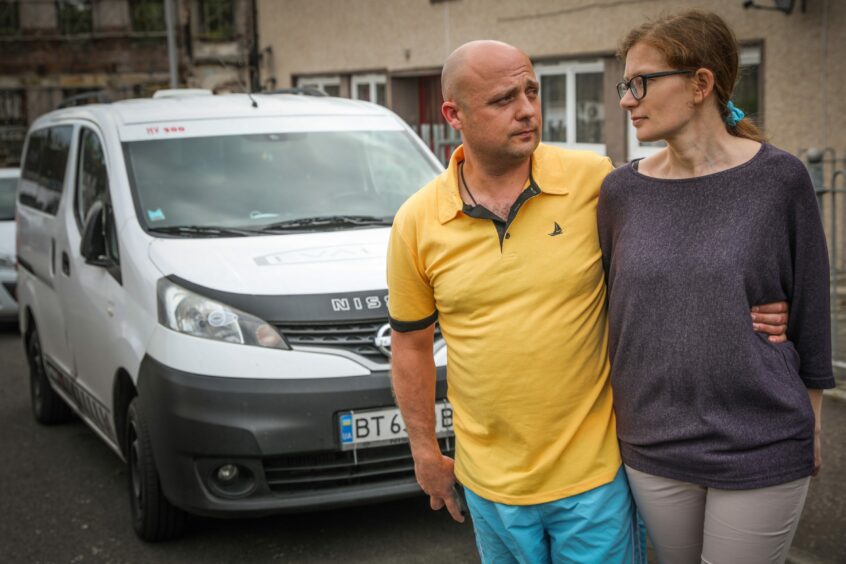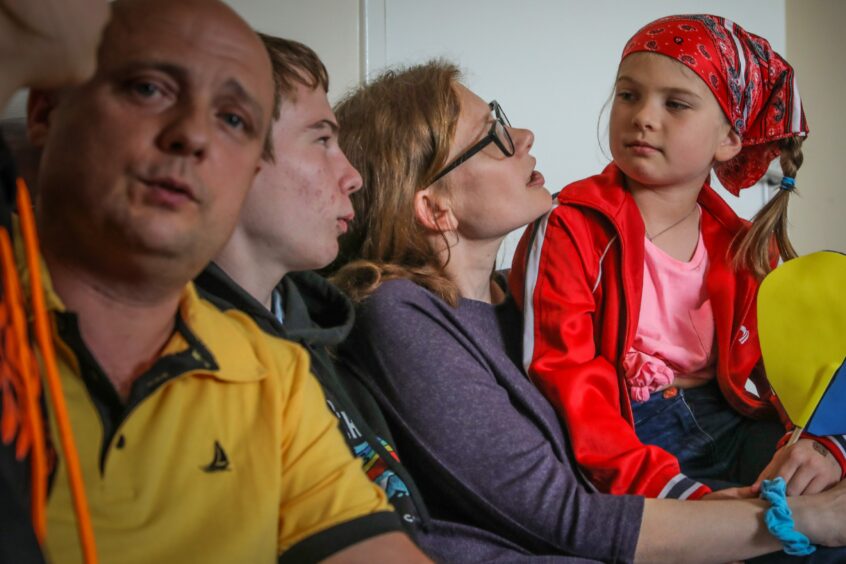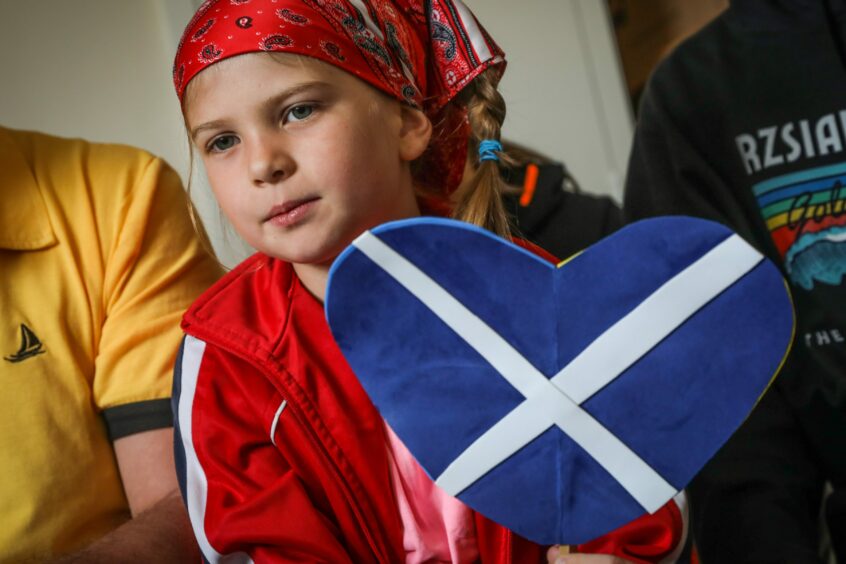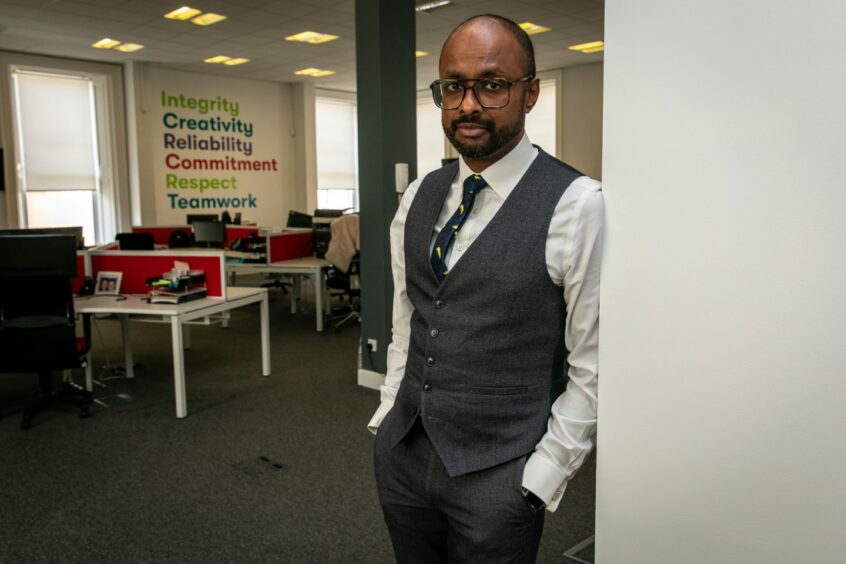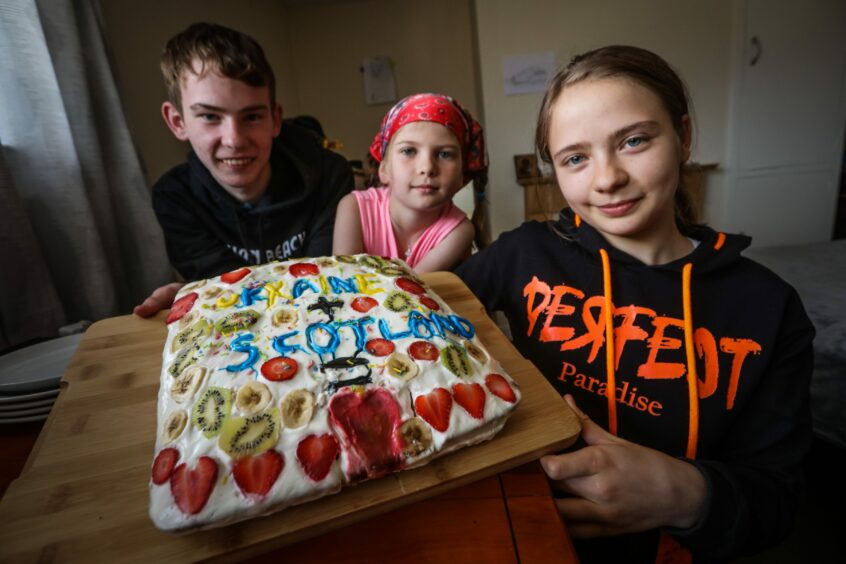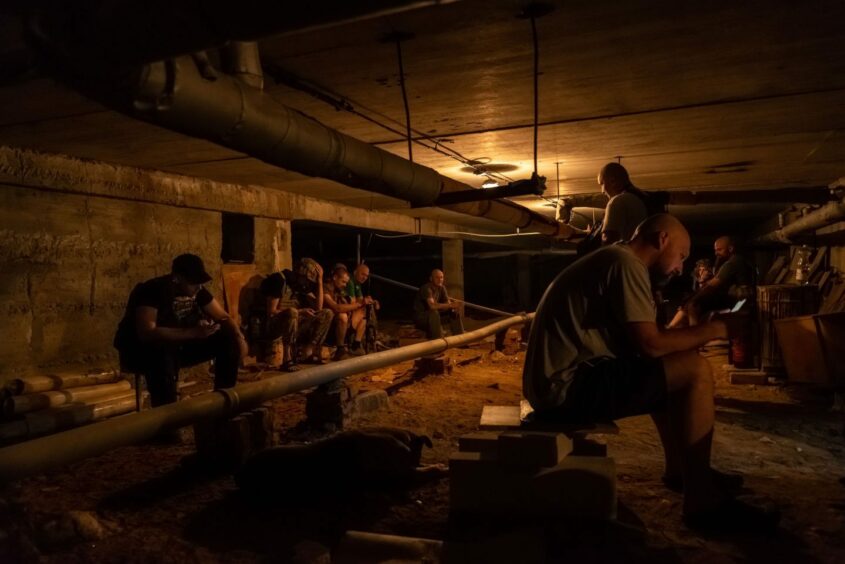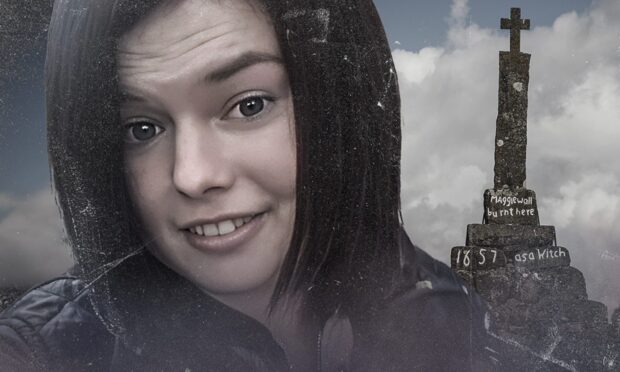Their home was destroyed by Russian bombs, forcing them to flee Ukraine.
During the treacherous journey from the city of Kherson to the Polish border and on to Cardenden in Fife they claim to have witnessed terrible atrocities – men, women and children murdered in front of their eyes.
They have accused Russian soldiers of horrific war crimes, killing their travelling companions.
Their names are Mykola and Tetiana Kartavtseva, an engineer and a primary school teacher.
Their three children are Mykola 16, Mariia, 15 and Daria, 8.
This is their story.
February 23: The day before the war
Mykola, 43, spent the evening fishing, watching the sunset over Antonovka – a suburb of Kherson situated on the banks of the Dnipro river where he and his family lived.
He never believed a war with Russia was imminent. He didn’t believe it would begin at all.
In the glow of the evening sun he was happy, pleased with his catch for the day.
Twelve hours later everything would be different.
February 24: The invasion of Ukraine begins
At 6am a ringing phone awakened Mykola from his sleep.
It was his father, over 100km away, with news he didn’t think possible.
He told him that the Russians had invaded – that the war had begun.
Mykola was not prepared. His son was staying with his mother and father in the distant village.
The grandparents were ill, his dad a diabetic and missing a leg, his mum badly asthmatic and barely able to move.
Location of Antonovka, Kherson Oblast (zoom out for detail)
Mykola and his wife Tetiana made the decision to travel the 100km distance and return with their son and Mykola’s parents.
But there was a problem.
“I was so sure that nothing like this could happen that I didn’t even have the car filled,” says Mykola.
“It was a completely empty petrol tank.
“We quickly got into the car with the whole family and drove to the gas station – and only at that moment we realised that the times and the world had changed.”
The roads were jammed. People were arguing, scared and screaming, carrying their belongings and pets in their arms.
The noise of air raid sirens filled the air, the sky black with smoke.
February 24: 9.30am
Having finally managed to refuel their car, Mykola set off on the 200km round-trip to find his parents and son.
The Courier has agreed to keep the name of the village anonymous for the safety of Mykola’s parents who remain in Ukraine.
“At about 11am we saw the remnants of our troops relocated behind the right side of the Dnipro river bank,” says Mykola.
“And then we saw the first Russian military – 12 Russian tanks stood in the vineyards to the left.”
At 1pm, on the first day of the war, Mykola received a phone-call from his neighbour that changed everything.
A battle had broken out on the Antonovsky Bridge near their home.
A Russian helicopter had fired six rockets at their house. Two had hit.
“One shell hit the exterior and destroyed the entrance,” says Mykola.
“The second went inside and destroyed the block.
“I had nowhere to go back.”
For four days a battle raged in Antonovka as the Russian army and Ukrainian civilians fought for control of the bridge.
The family’s hometown was bombarded with air missiles and artillery fire from tanks.
Mykola and Tetiana could not return home.
Instead, they were forced to stay in the village with Mykola’s parents.
A village that had already fallen to Russian occupation.
February 26: Behind enemy lines
On the third day of the occupation, Mykola and the male population of the village signed up to defend the area.
Entry points were covered with soil banks and ditches, anti-tank hedgehogs scattered and guarded checkpoints set-up.
Over the next few days and weeks Mykola and his family began to realise what it was like living in occupied territory.
“There is no money because there is no work,” explains Mykola.
“ATMs do not work, no one delivers cash.
“The stores are empty – there is no delivery of goods, other stores have closed themselves so as not to be plundered by Russian marauders.”
Mykola claims the village he was stranded in was bombed almost daily by the invading Russians.
“The missiles flew day and night,” he told The Courier.
“Some were defective and fell either outside the village or into a neighbouring village.
“Cluster bombs were also scattered, from which people were injured and killed.”
March: Preparing for battle
Whilst staying in the village, the family started hearing rumours of Crimean prisoners being sent to the area.
Afraid of what was to come, Mykola now believed he had no choice but to prepare his young family for war.
“We started preparing guns, pitchforks and so on,” said the father.
“My family and I prepared the basement – boarded up all the windows, filled it with furniture and started preparing Molotov cocktails.
“I taught my kids how to use them.
“And morally we were ready to give the last battle.”
Civilians in the village encountered further problems brought on by the occupation – they had no access to medicine or fuel.
Mykola claims numerous acquaintances he had made died due to the lack of medical facilities or operating pharmacies.
The family knew they had to get out of the occupied territory.
After nearly a month in the village, Mykola received a phone-call that gave them a chance to escape.
March 22: Heart-breaking goodbyes
The friend that called Mykola told him that fighting between Kherson and Mykolaiv had subsided and civilians had begun to break through the front.
Together they decided it was time to go.
But not all of them were able to make the journey.
Mykola’s parents told their son they did not want to leave their home.
They told him they would not survive the perilous road ahead.
The family also had to leave one other member behind – their beloved pet dog Rada, a Laika they had since she was a puppy.
She stayed with Mykola’s parents.
“I went and sobbed all the way, from my helplessness,” said Mykola.
“Because I practically left my weak parents there without medicine, without money, without food.”
With their home destroyed, Mykola decided their only option was to try and escape Ukraine and reach his only sister, Natalya, who lived in Fife.
As the family of five drove out of the occupied village they could never have imagined the horrors they would witness on their journey towards Scotland.
March 22: Checkpoints and fear
At the first checkpoint they reached, Russian soldiers checked their documents and waved them through.
“To our surprise they were not very aggressive,” said Mykola.
There were many more checkpoints on the way to Antonovsky Bridge where they were stopped again.
Mykola claims that at this checkpoint an order was given to shoot them.
“The commander gave the order to shoot us and take the car,” says Mykola.
“The soldier did not comply and told us to get in the car and drive.”
As they raced away from the checkpoint Mykola says he heard screams and shouting.
Looking back he saw the soldier who had saved their lives getting hit with the butt of a gun.
Driving towards Kherson was a terrifying experience for the family in their Nissan NV200.
“It was very scary to drive just on the roads,” said Mykola.
“Cars were fired upon.
“There were snipers sitting on roofs killing people.”
March 22 – 26: Trouble in Kherson
Fighting on the frontline started up again shortly after the family arrived back in their hometown meaning they could not leave again straight away.
Staying with friends, they drove to their destroyed home to see if anything could be salvaged from the wreckage.
About 100 metres from their house sat another Russian checkpoint.
As they drove through, they could see huge tailbacks of vehicles trying to escape Kherson.
“It was impossible to look at our house without tears,” said Mykola.
“What was not shot through, it was cut with fragments.
“Windows and doors were smashed out – there was no roof, the walls were destroyed, the ceiling was broken.”
As the they scrambled together some undamaged objects, Mykola and Tetiana were interrupted by Russian soldiers.
“Three Russian soldiers put us down with guns on the floor and started yelling at us that we have no right to be at our house without obtaining permission at the checkpoint,” said Mykola.
“At that moment I thought how stupid everything is.
“One of them told all of us to stand at the fence and that they would shoot us because we allegedly violated their rules and laws.”
Mykola claims the Russian soldier took their passports and only calmed down when he saw Mykola had been born in Crimea.
“He asked when was the last time I was in Crimea,” said Mykola.
“I answered in 2016 – at the funeral of a relative.
“To which he said: ‘Okay, this time I won’t shoot you, maybe you and I played football together in the same yard.’
“He was wearing a balaclava but I think we were about the same age.”
March 27: Claims of war crimes in Ukraine
A plan was hatched to put together a convoy of 12 vehicles with adults and children and take them out of the Kherson Oblast region through Stanislav.
At 6am Mykola and his family woke up and started packing.
The convoy painted the word “CHILDREN” on all the vehicles.
Some of the cars wrote the word in Ukranian, others in Russian.
Mykola says he agonised over which language to use before finally opting for Russian.
It was a decision he believes may have saved their lives.
The convoy left the city of Kherson through Bilozerka, passing numerous checkpoints.
Location of Bilozerka, Kherson Oblast (zoom out for detail)
These checkpoints were manned by soldiers from the LNR and DNR – pro-Russian separatists from the Donbas region.
“They were just boys who didn’t understand anything what they were doing there,” said Mykola.
“And men, over 50 years old, who also did not understand what they are doing there.”
At each checkpoint the pro-Russian soldiers took the convoy’s supplies.
Then the horror truly began to unfold. At one checkpoint, less than a 1.5-hour drive from Kherson, three of the cars were stopped.
These were the vehicles that had written the word “CHILDREN” in Ukranian and not Russian.
Mykola claims the passengers in these vehicles, children among them, were shot.
He claims they were killed.
March 27: Helicopters and minefields
The remaining members of the convoy made their way through Stanislav, heading towards the small village of Oleksandrivka and onto the Mykolaiv Oblast region.
After Stanislav they joined a row of cars heading the same direction as them.
Then the shelling started.
Mykola claims a Russian helicopter started bombing the row of cars in front of them.
As the helicopter turned to face their party, the driver of the car directly ahead of them froze.
Mykola could see the pilot in the helicopter around 100 metres away.
But the pilot didn’t shoot.
Nearby locals rushed to their aid and told the convoy and others in the row of cars to hide behind the concrete wall of a farm.
Stranded, they tried to form a plan.
A man in a red car said he counted three minutes between bombings and reloading.
He convinced them to make a dash for their lives between bombings.
Location of Olaksandrivka, Kherson Oblast (zoom out for detail)
“We took off over the field with such speed,” said Mykola.
“It was very scary. We were driving along a yellow dirt road on which the bodies of killed people, their things, bicycles were scattered.
“On the right we saw a lake in which the bodies of dead people floated.
“On the sides of the road were shot, burnt cars.”
Mykola claims when the Russian soldiers saw the cars making a break for freedom down the dirt road they opened fire, forcing them into a field.
The field had been laid with mines.
Two cars exploded – one of them was the red car of the man Mykola had been speaking to moments earlier.
He believes the man died in the explosion.
“We drove as fast as we could in the car,” said Mykola.
“There was a fog of dust from explosions, from cars, from explosions of shells.
“Time seemed to have stopped.
“The children were crying.
“I couldn’t even believe that all this was happening to us – as if it were just in some kind of action movie.”
Eventually they reached the Mykolaiv Oblast region with checkpoints manned by Ukranian soldiers.
But only six of the cars had made it. They had lost half their convoy in one day.
Men, women and children all presumed dead.
March 27 –28: ‘The war will not let us go’
Slightly lost due to bombed out road signs, Mykola and his family made their way towards Vinnitsa where they spent the night.
They arrived late at night and started looking for accommodation but nothing was available.
They contacted Mykola’s brother-in-law Tim, in Fife, who went online and booked them a place outside the city.
There was a Ukranian military unit enroute to their accommodation where the family were stopped and their documents checked.
They talked with three young officers for around 10 minutes, telling them their plans before heading to bed for the night.
When they returned through the checkpoint the next morning, Mykola claims the three soldiers had been killed.
“We realised that we were not safe in any way – that the war still did not let us go,” said Mykola.
The family travelled to Ternopil, then Lviv, before crossing the Polish border and driving to Krakow where they spent the night.
It had been little more than a month since Mykola enjoyed his evening fishing in the glow of the sunset over Antonovka, a suburb of Kherson, where his house used to stand.
It would be another few days before the family reached their new home in Fife.
Part Two: Language barriers, human trafficking and hope
Having escaped their war-torn country via the dangerous and terrifying route through the frontline, the family had safely made it across the border to Krakow and then Warsaw.
The next step of their plan was to reach Mykola’s sister in Glenrothes.
Sorting out their visa situation in Warsaw, the family of five departed for Scotland.
Over the next few days they would drive from Poland, through Germany, and into the Netherlands, where they caught a ferry from Amsterdam to Newcastle.
It was the first time the Kartavtsevas had travelled by boat and the ferry departed during a huge storm.
“We could not have dinner because of the storm,” said Mykola.
“Cups and plates flew off the table.
“We barely made it to the cabin where we lay – some on the bed, some on the floor.”
Around 2am the storm subsided and they managed to get some sleep.
At 9am they docked in England.
Mykola claims it was 3pm before customs finally cleared them to leave the port.
It was the first time Mykola had driven on the left side of the road – the first of many new things the family would experience as they adjusted to life in Fife.
Language a barrier to employment in Scotland
“When we entered Scotland, we faced a language barrier,” said Mykola
“We could not ask anything and understand nothing in return.”
After an emotional reunion with his sister, Natalya, reality began to set in for Mykola and Tetiana.
They began to panic. They both had good jobs in Ukraine but spoke almost no English.
The language barrier made it difficult to find employment.
The husband and wife started to worry how they would provide for their family.
“I realised that I had no money,” said Mykola.
“There were debts from the trip, no work, nowhere to live.
“I didn’t have any things with me from clothing to household items.”
Struggling to get a home or education
When they first arrived, the family lived with Natalya and her husband Tim in Glenrothes.
But it was cramped. A small house for a family of four suddenly had to sleep nine.
Mykola’s family slept in the living room and hallways.
The family were struggling with documentation to apply for accommodation and couldn’t get the children registered for school.
In April, a month after they arrived in Glenrothes, Tim introduced Mykola to his boss, Shan Saba – director of Brightwork recruitment agency and founder of Scotland Against Modern Slavery (SAMS).
Through his recruitment agency, Shan was able to get Mykola and Tetiana work in a fish factory.
He also helped them get a one-bedroom flat in Cardenden and the children registered in school.
“I saw Shan only once in my life at a fish factory where he helped me and my wife Tetiana get a job, without knowing English,” said Mykola.
“But throughout my stay in Scotland I constantly felt the invaluable support of this man.”
Refugees from Ukraine at risk of human trafficking
This investigation spoke to Shan about the situation Ukrainian refugees face after arriving in Scotland.
The modern slavery campaigner believes they are in danger of being preyed upon by traffickers.
The SAMS founder was particularly concerned with adverts appearing on social media targeted at those fleeing the war.
“Because of the language barrier they are at risk of being exploited because they are desperate for work,” explained Shan.
“When you go on some of the Facebook groups – you or I could set up these groups.
“The majority of people are open minded and want to help people out – but there’s some bad people out there.”
Shan also highlighted the stark rise in UK Google searches for Ukrainian escorts since the war began – one survey showing a 200% rise in the term.
The campaigner fears there will be a number of Ukrainian victims of modern slavery in Scotland whose experiences are yet to come to light.
“We won’t hear the stories of exploitation, it will take a while for them to filter through – but they’ll come through, guaranteed,” says Shan.
“And that’s the bit that concerns me.
“It all been done so quickly. There are people coming into the UK but where’s the safeguarding in all this?”
Ukrainian love for Scotland
The Kartavtseva family have been overwhelmed with the support they have received since they arrived in Fife.
When this investigation met with the family at their flat in Cardenden they had baked a Ukrainian ‘zebra’ cake earlier that day to show their appreciation of the welcome they have received.
Mykola said: “We are still amazed at the number of Ukrainian flags that we see on the roofs of the houses of the Scots.
“All of them support Ukrainian and pray for our people – this is a huge moral support which is so necessary in a difficult moment.
“I hope that in the near future our family will also be able to help those in need, both in Scotland and in Ukraine and other countries.”
Hope to rebuild Ukraine
The dad says that he hopes one day his family can help rebuild the country they were forced to flee.
“Our hearts and souls are damaged from the events that have happened to us,” says Mykola.
“We no longer have our home in Ukraine, our former happy life.
“Yes, we were sheltered and warmed by affectionate Scotland but we still fall asleep and wake up there – in our homeland.
“We very much hope that one day we will be able to make the necessary contribution and restore our homeland.”
Part Three: The war in Kherson, Stanislav and Oleksandrivka
Fighting in the Kherson Oblast region has been ongoing since the Russian invasion began on February 24.
In keeping with Mykola’s claims, reports of attacks around Antonovsky Bridge, beside his family’s home, date back to the first day of the war.
The route taken by Mykola and others on the convoy from Kherson through Stanislav to Oleksandrivka (Aleksandrovka) and on to Mykolaiv (Nikolaev) also appears to have been in operation around the date of March 27 as per this report from The Guardian.
A Ukrainian journalist reporting from Kherson says a friend of hers made the same journey on March 25 – two days before Mykola’s convoy departed.
She describes the journey as a “great risk” and a “roulette wheel”.
The report also backs up Mykola’s claims of fatalities arising from lack of medical facilities.
“The humanitarian disaster continues,” she writes.
“According to volunteers, we have more deaths from lack of medication than from bullets.”
March 27
Russian shelling of the Stanislav and Oleksandrivka area of Kherson Oblast on March 27, the day Mykola’s claims they were attacked, has also been reported locally.
This March 28 story from Bropy, a media outlet reporting on the Kherson region, quotes Ivan Samoilenko, head of the Stanislav community, as saying the night before (March 27) had been like the previous night – disturbing with shelling.
A post on the same website from March 27 quotes Mr Samoilenko stating that people were injured, houses, electricity and gas supplies all damaged.
Location of Stanislav, Kherson Oblast (zoom out for detail)
A report from Ukraine Crisis Media Centre detailing events in Kherson Oblast on March 27 also describe fighting in Stanislav.
It states: “Fighting continues in the areas near the Mykolaiv area, namely in Stanislav and Velyka Oleksandrivka.
“Information on the destruction and casualties is being clarified.”
Deaths in Stanislav
Overall the shelling and fighting appears to have been widespread across the area in the days surrounding the convoy’s attempted escape.
A report from Suspline Media, the national public broadcaster in Ukraine, states that heavy shelling from Russian military on civilian infrastructure in Stanislav on the night March 23 – 24 resulted in the deaths of two men.
They state that the Kherson prosecutor’s office opened a criminal investigation into the shelling.
On March 31, Suspilne reported that 73 people had been evacuated from Stanislav and Oleksandrivka.
They also say that, according to community leader Ivan Samoilenko, 12 children were also evacuated from Stanislav on March 31 with the aid of Kherson Red Cross.
On May 16, Suspline posted drone footage showing the destruction of Oleksandrivka village near Stanislav on their Telegram social media channel.
The footage, which was shared by media channel Liveuamap on Twitter, shows destroyed buildings and roads.
The video also shows what appears to be many tyre-tracks careering through the fields surrounding the village.
Video: Destruction in Oleksandrivka village of Stanislav community of Kherson region https://t.co/EWysUcYN9D pic.twitter.com/UPSaxlYSqK
— Liveuamap (@Liveuamap) May 16, 2022
